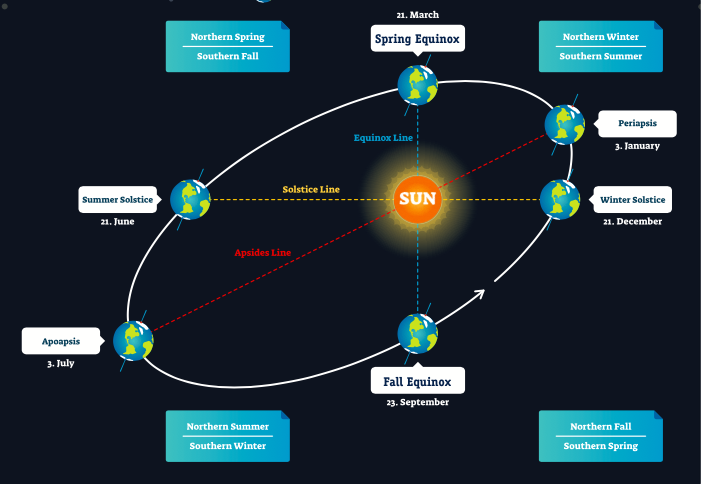
HAVE YOU HEARD PEOPLE SAY “HAPPY WINTER SOLSTICE” OR “HAPPY SPRING EQUINOX”? FROM ANCIENT TIMES, MANY PEOPLE AROUND THE WORLD HAVE CELEBRATED THESE SPECIAL DAYS THAT MARK THE STAGES IN EARTH’S JOURNEY AROUND THE SUN. BUT WHAT DO THESE WORDS MEAN?
IT’S ALL ABOUT THE ANGLE
The Earth is tilted on its axis (the imaginary line running from the north pole to the south pole). As it journeys around the Sun, it spins around its axis, giving us day (when facing the Sun) and night (when our part of the world is turned away from the Sun). But even with all this spinning and orbiting, the angle of the axis stays the same. So the Northern Hemisphere is tilted toward the Sun in the summer months and away from the Sun in the winter. (For the Southern Hemisphere, it’s the opposite). This tilt of the Earth’s axis is what gives us the seasons. When tilted towards the Sun, we have more hours of daylight and direct rays, so the weather is hotter. The effect is strongest near the poles. That’s why in the far north, it’s dark for most of the day in winter and light for most of the night in summer, while in countries near the equator, day and night are close to equal all year long.
DID YOU KNOW?
THE EARTH’S ORBIT AROUND THE SUN IS NOT A PERFECT CIRCLE. IT IS AN ELLIPTICAL ORBIT, MEANING THE CIRCLE IS STRETCHED INTO AN OVAL SHAPE. MANY PEOPLE THINK THAT THIS IS THE CAUSE OF THE SEASONS – THAT THE WEATHER IS HOTTER AT THE TIMES WHEN EARTH IS CLOSER TO THE SUN AND COLDER WHEN WE ARE FARTHER AWAY. THAT’S NOT TRUE. IN FACT, IN THE NORTHERN HEMISPHERE, THE EARTH IS CLOSEST TO THE SUN DURING THE WINTER AND FARTHEST AWAY IN SUMMER!
THE AVERAGE DISTANCE BETWEEN THE EARTH AND THE SUN IS 149.60 MILLION KM
The two SOLSTICES occur in summer and winter when the Earth’s tilt towards or away from the Sun is the greatest. For every place north of the Tropic of Cancer, the summer solstice (around June 21st) has the longest daylight hours and is the year’s longest day.
The winter solstice (on December 21st this year) is the shortest day of the year.
The two EQUINOXES occur in spring and fall when the Earth’s axis is not pointing either towards or away from the Sun (more like sideways to the Sun). On those days, the daylight and darkness hours are equal.

Visit our website for more content or to subscribe!

